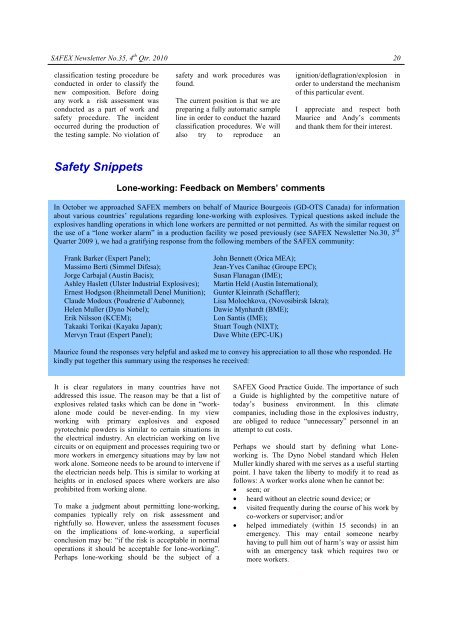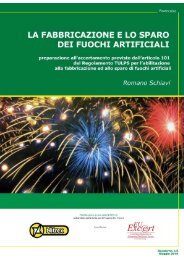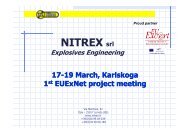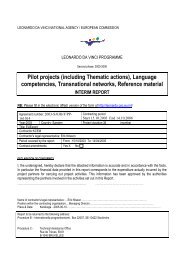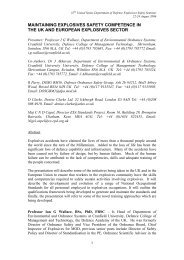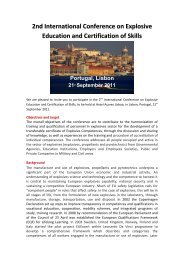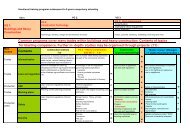SAFEX Newsletter No.35 - EU-Excert
SAFEX Newsletter No.35 - EU-Excert
SAFEX Newsletter No.35 - EU-Excert
Create successful ePaper yourself
Turn your PDF publications into a flip-book with our unique Google optimized e-Paper software.
<strong>SAFEX</strong> <strong>Newsletter</strong> <strong>No.35</strong>, 4 th Qtr. 2010 20<br />
classification testing procedure be<br />
conducted in order to classify the<br />
new composition. Before doing<br />
any work a risk assessment was<br />
conducted as a part of work and<br />
safety procedure. The incident<br />
occurred during the production of<br />
the testing sample. No violation of<br />
safety and work procedures was<br />
found.<br />
The current position is that we are<br />
preparing a fully automatic sample<br />
line in order to conduct the hazard<br />
classification procedures. We will<br />
also try to reproduce an<br />
ignition/deflagration/explosion in<br />
order to understand the mechanism<br />
of this particular event.<br />
I appreciate and respect both<br />
Maurice and Andy’s comments<br />
and thank them for their interest.<br />
Safety Snippets<br />
Lone-working: Feedback on Members’ comments<br />
In October we approached <strong>SAFEX</strong> members on behalf of Maurice Bourgeois (GD-OTS Canada) for information<br />
about various countries’ regulations regarding lone-working with explosives. Typical questions asked include the<br />
explosives handling operations in which lone workers are permitted or not permitted. As with the similar request on<br />
the use of a “lone worker alarm” in a production facility we posed previously (see <strong>SAFEX</strong> <strong>Newsletter</strong> No.30, 3 rd<br />
Quarter 2009 ), we had a gratifying response from the following members of the <strong>SAFEX</strong> community:<br />
Frank Barker (Expert Panel);<br />
Massimo Berti (Simmel Difesa);<br />
Jorge Carbajal (Austin Bacis);<br />
Ashley Haslett (Ulster Industrial Explosives);<br />
Ernest Hodgson (Rheinmetall Denel Munition);<br />
Claude Modoux (Poudrerie d’Aubonne);<br />
Helen Muller (Dyno Nobel);<br />
Erik Nilsson (KCEM);<br />
Takaaki Torikai (Kayaku Japan);<br />
Mervyn Traut (Expert Panel);<br />
John Bennett (Orica MEA);<br />
Jean-Yves Canihac (Groupe EPC);<br />
Susan Flanagan (IME);<br />
Martin Held (Austin International);<br />
Gunter Kleinrath (Schaffler);<br />
Lisa Molochkova, (Novosibirsk Iskra);<br />
Dawie Mynhardt (BME);<br />
Lon Santis (IME);<br />
Stuart Tough (NIXT);<br />
Dave White (EPC-UK)<br />
Maurice found the responses very helpful and asked me to convey his appreciation to all those who responded. He<br />
kindly put together this summary using the responses he received:<br />
It is clear regulators in many countries have not<br />
addressed this issue. The reason may be that a list of<br />
explosives related tasks which can be done in “workalone<br />
mode could be never-ending. In my view<br />
working with primary explosives and exposed<br />
pyrotechnic powders is similar to certain situations in<br />
the electrical industry. An electrician working on live<br />
circuits or on equipment and processes requiring two or<br />
more workers in emergency situations may by law not<br />
work alone. Someone needs to be around to intervene if<br />
the electrician needs help. This is similar to working at<br />
heights or in enclosed spaces where workers are also<br />
prohibited from working alone.<br />
To make a judgment about permitting lone-working,<br />
companies typically rely on risk assessment and<br />
rightfully so. However, unless the assessment focuses<br />
on the implications of lone-working, a superficial<br />
conclusion may be: “if the risk is acceptable in normal<br />
operations it should be acceptable for lone-working”.<br />
Perhaps lone-working should be the subject of a<br />
<strong>SAFEX</strong> Good Practice Guide. The importance of such<br />
a Guide is highlighted by the competitive nature of<br />
today’s business environment. In this climate<br />
companies, including those in the explosives industry,<br />
are obliged to reduce “unnecessary” personnel in an<br />
attempt to cut costs.<br />
Perhaps we should start by defining what Loneworking<br />
is. The Dyno Nobel standard which Helen<br />
Muller kindly shared with me serves as a useful starting<br />
point. I have taken the liberty to modify it to read as<br />
follows: A worker works alone when he cannot be:<br />
• seen; or<br />
• heard without an electric sound device; or<br />
• visited frequently during the course of his work by<br />
co-workers or supervisor; and/or<br />
• helped immediately (within 15 seconds) in an<br />
emergency. This may entail someone nearby<br />
having to pull him out of harm’s way or assist him<br />
with an emergency task which requires two or<br />
more workers.


